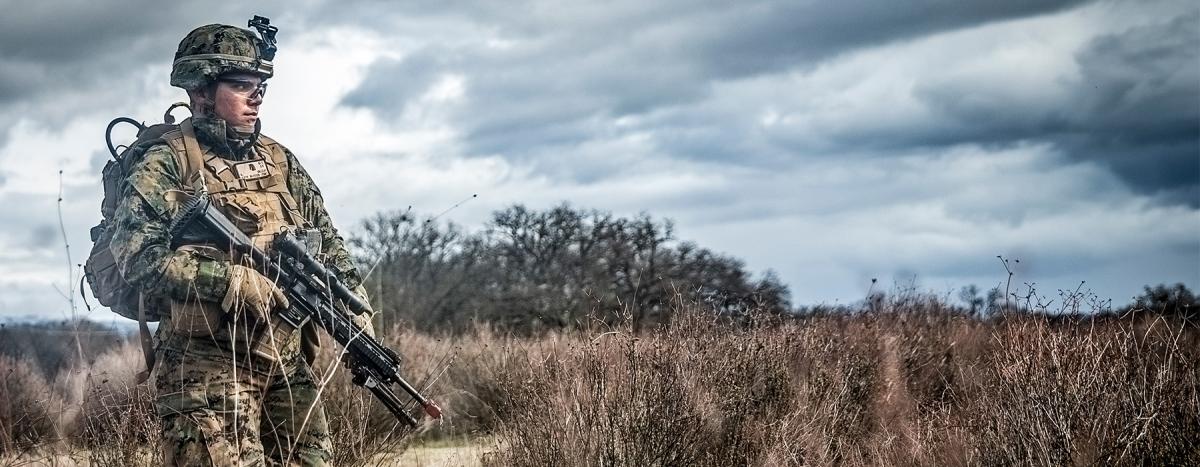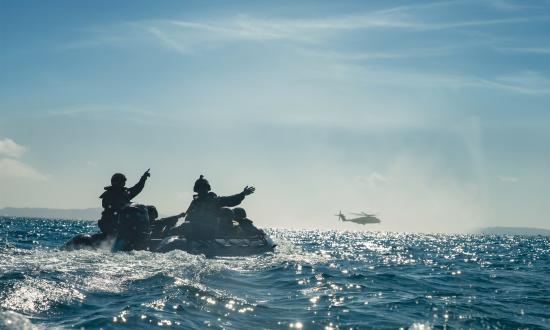The current Marine expeditionary unit (MEU) is failing to provide the Marine Corps and joint force the flexibility, capability, and functionality needed in the 21st-century fight. Specifically, the MEU lacks an expeditionary forward arming and refueling point (FARP) capability as part of the current task organization and table of equipment. What is more, Marine Corps publications, manuals, and articles provide conflicting guidance for addressing this problem. The Tentative Manual for Expeditionary Advanced Base Operations and the Commandant’s Planning Guidance acknowledge the importance of FARPs in the future fighting environment but conflict with current doctrinal standards and guidance outlined in Marine Corps Tactical Publication (MCTP) 3-20B, Aviation Ground Support.
MCTP 3-20B’s guidance that FARPs should be established outside the missile engagement zone directly conflicts with Commandant General David H. Berger’s overall guidance to the Marine Corps as a “stand-in force.”1 It also contradicts the Tentative Manual’s doctrine on existing in the adversary weapons engagement zone (WEZ). The Tentative Manual notes: “FARPs are especially salient, because they increase the operational reach of aviation forces, add resilience to aviation logistics . . . and increase flexibility for the use of aviation,” which must be addressed with additional force design measures.2 By following the Commandant’s number one priority, the MEU can address and fix contradictions in current guiding documents. The MEU needs an expeditionary FARP capability that is doctrinally defined, properly task organized and manned, trained, equipped, and led by specialists.
MCTP 3-20B states: “The size of the FARP varies with the mission and the number of aircraft to be serviced.”3 Establishing a FARP requires a deliberate planning process with input from multiple enablers. Planners can establish four kinds of FARPs: static, cold, assault, and fixed-wing. Each requires a different combination of equipment, support personnel, and operational considerations. Thus, the equipment needed to provide the full range of aviation ground support is very large. However, since space on amphibious ships is finite, it is impossible for a MEU to provide the full spectrum of FARP capabilities. Furthermore, deliberate FARP planning and execution inherently contrasts with the expeditionary, rapid response nature of MEU operations. The MEU needs a standard FARP package to increase its ability to support combat operations through a rapidly deployable, standardized mission.
FARPs increase the MEU’s ability to generate sorties by creating an additional ground-based hub for aircraft to refit and rearm. This also provides the MEU with the capability to launch aircraft and depart the area, allowing naval vessels to exit the WEZ and increase operational reach. Meanwhile, the aircraft can still access the ships’ logistics through the smaller and more cost-effective FARP. As new logistical resupply methods such as 21st-century foraging (activities that reduce the need to resupply the unit) and host-nation support are developed, it is critical the core FARP capability be completely organic to the MEU, so it does not rely on resources and personnel outside its direct control and authorities.
MEU FARP Metrics and Processes
Defining a MEU FARP first requires standard metrics for success. Since the objective is to standardize the personnel and equipment to enhance rapid deployment, planning generally will occur without knowing the exact flight mission. Success can be defined by using the metrics of extended flight time or extended distance for a section of aircraft. In this way, inserting a FARP can be justified without worrying about diminishing returns.
Success for assault aircraft is 200 miles or 90–120 minutes of additional on-station time, which equates to roughly 3,000 pounds (lbs) of fuel for MV-22 Ospreys and 7,500 lbs of fuel for CH-53 Super Stallions. Success for F-35B Lightning II fighter aircraft is 5,000 lbs of fuel, which extends their combat radius enough to justify the insertion of fuel sites. Success for attack rotary-wing aircraft in comparison is very simple—2,300 to 2,500 lbs, which is almost a full tank. Considering all this information, the pacing element for success is 15,000 lbs of fuel—enough for two assault aircraft.
With the metrics for success defined, the composition of the MEU FARP can be standardized. The FARP must be flexible and expeditious. MEU aircraft and personnel must be capable of moving it quickly and efficiently. The working assumption must be that surface connectors will not be available because of tidal windows, competing priorities, and hostile activity. The MEU FARP will consist of multiple, dispersed, and hidden fuel sites, fuel teams, and a headquarters element. The composition will be four to eight 3,000-gallon fuel bags, one to two Tactical Aviation Ground Refueling Systems (TAGRS), and one to two Polaris MRZR all-terrain vehicles. The MRZR/TAGRS combination is the ideal equipment for expeditionary fuel operations. The MRZR is an ultralight, compact vehicle capable of transporting four Marines with room for some equipment. Most important, it can pull the TAGRS—an off-road-capable trailer with built-in hoses, pumps, filters, water separators, and fire extinguishers. Marine Wing Support Squadron 371 recently employed this system and reduced F-35B refueling time by 90 percent.4
The fuel team will consist of 6 to 12 Marines: four Marines per MRZR/TAGRS with a two-Marine headquarters element. This composition requires two CH-53s or two MV-22s to insert and can be loaded and unloaded without forklift support. Each aircraft carries a MRZR/TAGRS combination along with a team of Marines. Two 3,000-gallon bags, each capable of holding 18,000 lbs of fuel, can be folded and strapped to pallets, with one pallet going in each aircraft. The pallets can be dragged by a team of Marines or more easily moved by attaching heavy-duty casters to them. Once inserted, the bags will be displaced in accordance with available terrain and the enemy situation, and at the minimum distance to ensure that two bags cannot be destroyed or compromised with one enemy missile.
Once the bags are in place, they will need to be filled by air-delivered, ground refueling—ideally by the aircraft that dropped them off. Next, the fuel team will create multiple hide sites separate from the bags and maintain low physical and emission signatures. When an aircraft is inbound, the aircrew will contact the fuel team and be given a brevity code that indicates which fuel site to use. A well-practiced TAGRS team can begin pumping fuel within five minutes.5
A Pacific Airfield Example
Seizing an adversary airfield is a common scenario requiring a MEU FARP. Lessons from various Combat Logistics Battalion 31 exercises in the Indo-Pacific and Marine Aviation Weapons and Tactics Squadron 1 training exercises at the Weapons and Tactics Instructor Course highlight the complexity of these operations. Throughout both commands, a friction point is that shifting the main effort within an organic unit (e.g., infantry battalion assigning a specific company the role of main effort per phase of the mission) can be a viable option, yet shifting main efforts across the Marine air-ground task force (MAGTF) with multiple major subordinate commands creates confusion on the battlefield.
Once the decision has been made in pre-mission planning that the airfield seizure will lead to establishing a FARP, the MEU commander must make the FARP aspect of the mission the main effort. Rather than shifting main efforts as the mission progresses, leaders must consider which entity is the supported and which the supporting unit as the mission progresses.
For example, in an airfield seizure, the rifle company is the supported unit while conducting the seizure. Once the objective is seized, the infantry company becomes the supporting unit to facilitate the flow of combat power and resources ashore and assumes the security role in support of future FARP operations. The FARP is now the supported unit in the mission progression yet remains the main effort throughout the entirety of the mission.
Creating flexibility for commanders afloat and ashore is necessary when developing the command-and-control structure. The possibility of adding a third command-and-control-specific MRZR all-terrain vehicle is a viable option with some potential risks. Transporting this asset requires another aircraft to fly into the WEZ while the FARP resources are established. Despite this risk, supplying the mission commander with additional headquarters assets, such as a joint terminal attack controller or fires coordinator, adds skills to the team. Digital interoperability via the Android Team Awareness Kit, Marine Common Handheld, Marine Air Ground Tablet, and other options in development will link the FARP mission commander to higher headquarters afloat and to additional assets that enter the battlespace.
To minimize signature, the team must adhere to specific communication windows or emissions timelines. Detailed coordination must be agreed to in the planning phase regarding when to divert from these specific windows. Once the FARP is established, and depending on the operational environment, the FARP commander should try to set communication windows to high local emission times or when the adversary is less likely to monitor the emissions spectrum.
The single-battle concept discussed in Marine Corps Warfighting Publication 3-10 still applies in this environment. The MEU commander must synchronize the collective efforts of the MAGTF to be operationally effective.6 To ensure synchronization at the tactical level, the FARP must also have a single commander, who should be a graduate of the Aviation Ground Support–Weapons and Tactics Instructor Course. “The WTI Course emphasizes integrated training between all facets of aviation, aviation ground support, and supporting arms working within the Marine Air Command and Control System while in support of a MAGTF and Joint scheme of maneuver.”7
Over seven weeks of training, WTI students are immersed in planning and executing training events that integrate the six functions of Marine aviation, while also planning for ground tactical plan–enabling actions and aviation support. A weapons-and-tactics instructor has the requisite knowledge and experience from this instruction to integrate the multiple assets of a MAGTF that support FARP operations.
While MCTP 3-20 states, “The establishment and operation of a FARP is an aviation operation,” the character of war is changing, and the Marine Corps must change with it.8 New solutions to warfighting functions such as logistics and command-and-control must be developed at the tactical level and honed at the operational level. The MEU FARP’s efficiency, survivability, and capability can improve significantly. A standardized mission-and-task organization and table of equipment create simplicity in embarkation and planning while still allowing a certain level of flexibility. Most important, a specially trained FARP mission commander enforces the single-battle concept and makes the MEU FARP more lethal.
1. Headquarters Marine Corps, MCTP 3-20B, Aviation Ground Support (Washington, DC: October 2018), 7-3; Gen David H. Berger, USMC, 38th Commandant’s Planning Guidance (Washington, DC: July 2019), 10.
2. Headquarters Marine Corps, Tentative Manual for Expeditionary Advanced Base Operations (Washington, DC: February 2021), 6–10.
3. MCTP 3-20B, Aviation Ground Support, 7-1.
4. LCpl Julian Elliott-Drouin, USMC, “MWSS-371 Employs TAGR System during FARP Operation,” Marines.mil, 21 February 2020.
5. Elliott-Drouin, “MWSS-371 Employs TAGR System.”
6. Headquarters Marine Corps, MCWP 3-10, MAGTF Ground Operations, 1-1.
7. Marine Corps Order 3500.19A, “Marine Corps Aviation Weapons and Tactics Training Program” (December 2019), 1-1.
8. MCTP 3-20B, Aviation Ground Support, 7-1.







